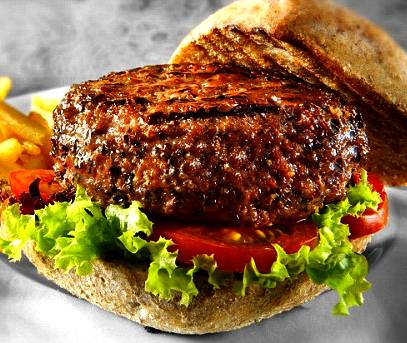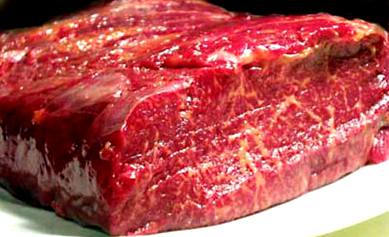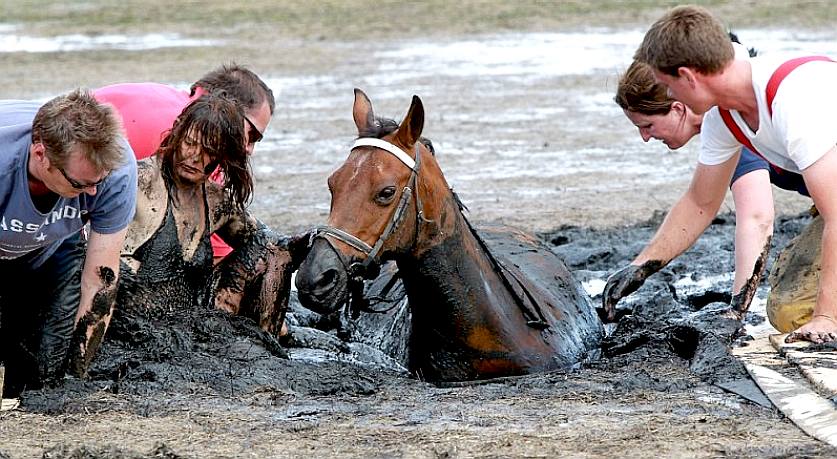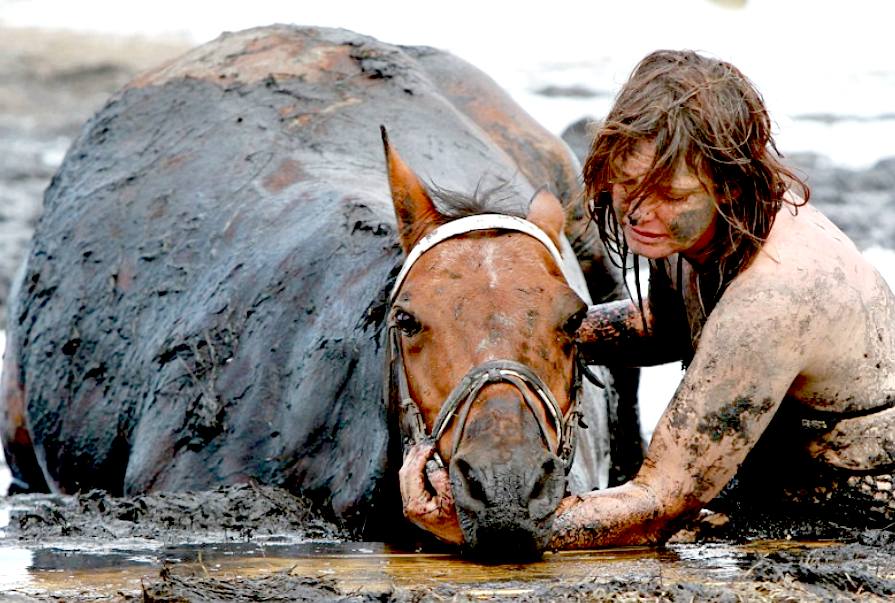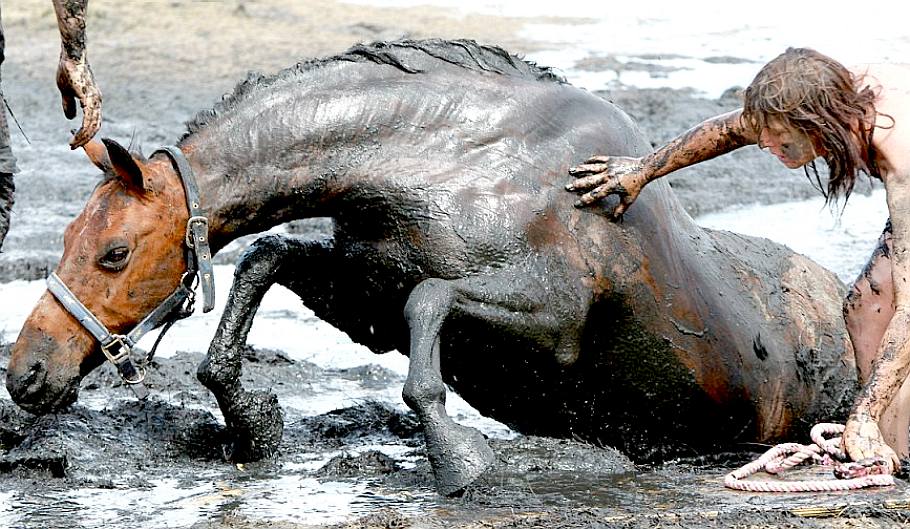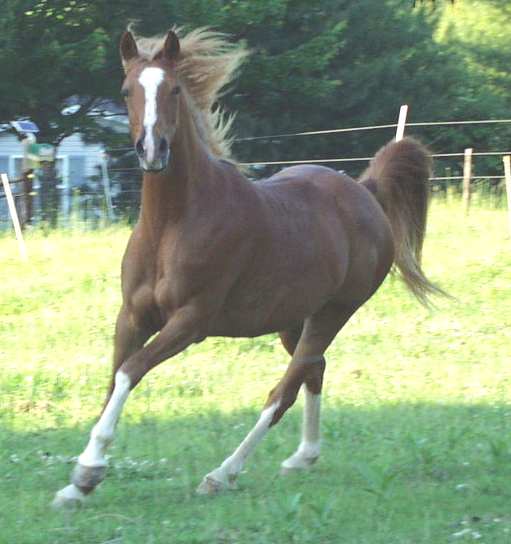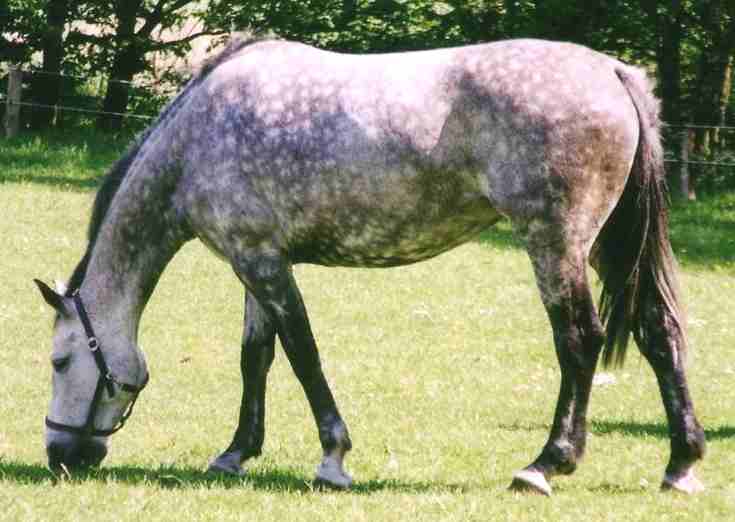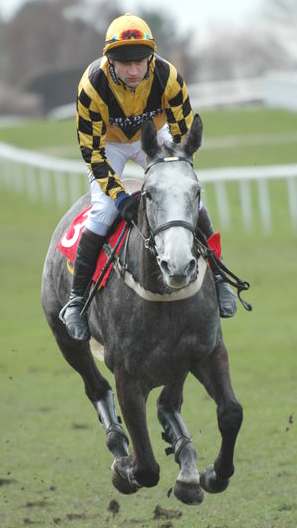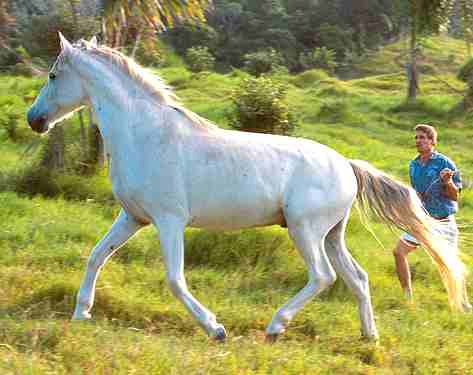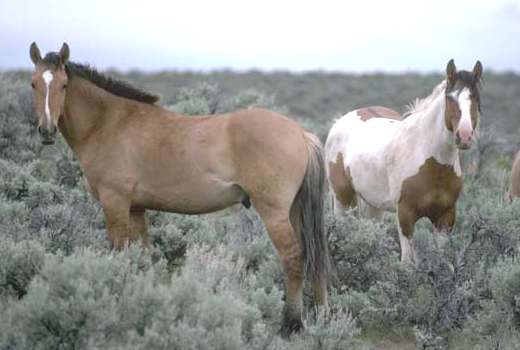|
HORSES
|
|||||||||||||||||||||||||||||||||||||||||||||||
|
The horse must rank high as one of man's best friends. They were transport for us for hundreds of years. They are also rather beautiful animals with a sense of humour, and when their useful life is over they are also food for us and other animals, though this is a sensitive topic in horse sentimental UK, where we'd rather import horse meat and let our farmers suffer to once remove us from the rearing aspect for us to enjoy a varied diet. Utter nonsense and discrimination against British farmers.
Fortunes have been made and lost on horses and some have become legends, such as that earthy little fighter Seabiscuit. In times of war, a man and horse together, became the cavalry. A horse is also a companion and a rewarding hobby, or indeed a sporting performance creature, which I'm in favour of, provided the horse is not hurt. Either way they are marvelous creatures, but as with any animal you must look after and love them.
More than a friend, a mode of transport, a sporting ride and a food source the world over. Yes, the horse is a beautiful animal, but so are most other animals. So why the fuss when it comes to eating them? Horse meat has less fat and cholesterol than beef, so is healthier for us. Okay, we all draw the line somewhere and I wouldn't eat a pet cat or dog - not unless I was starving somewhere in the barren snowy wilderness. In such situations humans have eaten other humans. Thus, the line moves with circumstance. In the UK we don't eat horse routinely, but in France and other European countries, horse meat is traded just the same as lamb, beef or pork. It makes good economic sense to do so and we are missing out on a valuable resource by not letting our good friend serve us to the end.
The horse (Equus caballus or Equus ferus caballus) is a large ungulate mammal, one of ten modern species of the genus Equus. Horses have long been one of the most economically important domesticated animals, and have played an important role in the transport of people and cargo for thousands of years. While isolated domestication may have occurred as early as 10,000 years ago, clear evidence of widespread horse use by humans dates to around 2000 BCE.
Like few other animals, horses can be ridden, either with or without a saddle. They can also be harnessed to pull objects like wheeled vehicles or plows. In some cultures, horses are a source of food, often horse meat and sometimes milk; in other cultures it is taboo to eat them.
Today, in wealthy countries, horses are predominently kept for leisure and sporting pursuits. However, around the world they continue to fulfill a wide range of economic functions.
Humans have bred horses for millennia, as with dogs, resulting in many different breeds. Some are well-known for particular qualities or abilities; for example, thoroughbreds for their racing speed.
There is nothing wrong with our horses, but if you want a horse burger in the UK, you'll have to import the meat from Europe, even though we are supposed to have a common agricultural policy. Piffle. The UK discriminates against UK horse farmers.
BRITISH CURIOSITY IS PRICKED JAN 2013
Horse burger sales have surged in the last fortnight with one retailer reporting a ten-fold increase since the horse meat scandal broke.
The revelation that thousands of beef burgers eaten by British families may have been contaminated with
horse meat provoked widespread revulsion across the UK.
But for hundreds of shoppers it only served to pique their curiosity.
Independent butchers have reported a general spike in sales since the horse meat scandal, he added. ‘We’ve seen a lot more young mums coming in to buy beef burgers. They used to buy their cheap cuts at the supermarket, but they’ve lost their faith in them. ‘We get a lot of new customers every time there’s a scare – foot and mouth, bird flu, and now horse meat in beef burgers.’
Less fat and less cholesterol than beef and there is tons of it going the waste in the UK. Some farmers have to pay to burn the carcasses to dispose of them because our government can't see the wood for the trees. There's money in them thar fields boys. Don't be so stupid and let us reap the rewards even only in the interests of our economy. Or, do we need another war before eating horse meat is acceptable?
EXOTIC MEATS
Buy horse meat online in the UK from Exotic Meats, they have horse burgers, sausages and steaks to purchase, you can buy online with confidence from Exotic Meats. Their horse meat is direct from continental Europe and is a naturally lean and tender meat as well as a healthy alternative to beef etc. Some customers get a little squeamish with regards horse meat in the UK but rest assured this meat comes from approved sources with an excellent track record of sustainable meat production. Only in the UK is horse a controversial meat. Elsewhere it is enjoyed as a matter of course in several European countries as well as a major meat in Asia, Mexico, Iceland and Argentina.
Why not try their Reindeer Meat as enjoyed by the Scandinavians for years and been a staple food for some indigenous groups for thousands of years. Scandinavia sourced Reindeer Meat is an exquisite form of venison that just has to be tried, the haunch is one of the best tasting meats available in the world today as recently proven by Gordon Ramsey and other top chefs worldwide.
Storeship Ltd
ABOUT
HORSES The
domestic horse can live to 20 or 30 years old. The mare is
pregnant for 11 months and gives birth to one foal (male: colt,
female: filly). They reach sexual maturity at 1-2 years old. The
size of horses varies considerably, depending on the breed:
light horses such as Arabians, Morgans, Quarter Horses, Paints
and Thoroughbreds weigh up to 1300lbs (about 595kg), whereas
heavy or draft horses such as Clydesdale, Draft, Percherons, and
Shire horses can weigh up to 2000lbs (about 907kg). Ponies can
be much tinier, down to the size of a large dog. Eohippus,
the ancestor of all modern horses was
only 20cm (about 8 inches) high Horses
and other equids are odd-toed ungulates of the order Perissodactyla,
a relatively ancient group of browsing and grazing animals that
first arose less than 10 million years after the dinosaurs
became extinct. Perissodactyls were the dominant group of large
terrestrial browsing animals until the Miocene (about 20 million
years ago), when even-toed ungulates, with stomachs better
adapted to digesting grass, began to outcompete them. All
equids are part of the family Equidae, which dates back
approximately 54 million years to the Eocene period. At one time
there were twelve families of odd-toed ungulates, though today
only three survive; tapirs and rhinoceroses are the closest
living relatives of the modern horse. The
genus Equus, to which all living equids belong, evolved a few
million years ago. Examples of extinct horse genera include:
Propalaeotherium, Mesohippus, Miohippus, Orohippus, Pliohippus,
Anchitherium, Merychippus, Parahippus, Hipparion, and Hippidion. Horses
as a species are believed by scientists to have first evolved in
what is now North America. Horse evolution was characterized by
a reduction in the number of toes, from five per foot, to three
per foot, to only one toe per foot (late Miocene 5.3 million
years ago); essentially, the animal was standing on tiptoe. One
of the first true horse species was the tiny Hyracotherium, also
known as Eohippus, "the dawn horse", which had
4 toes on each front foot (missing the thumb) and 3 toes on each
back foot (missing toes 1 and 5). Over about five million years,
this early equid evolved into the Orohippus. The 5th fingers
vanished, and new grinding teeth evolved. This was significant
in that it signalled a transition to improved browsing of
tougher plant material, allowing grazing of not just leafy
plants but also tougher plains grasses. Thus the proto-horses
changed from leaf-eating forest-dwellers to grass-eating
inhabitants of the Great Plains. Competing
theories exist as to the time and place of initial
domestication. The earliest evidence for the domestication of
the horse comes from Central Asia and dates to approximately
4,000 BCE. Archaeological finds such as the Sintashta chariot
burials show how far this domestication had progressed. Wild
species continued to survive into historical times and,
arguably, until today. For example, the Forest Horse (Equus
ferus silvaticus, also called the Diluvial Horse) is thought
to have evolved into Equus ferus germanicus, and may have
contributed to the development of the heavy horses of northern Europe,
such as Ardennais. The
tarpan, Equus ferus ferus, became extinct in 1880. Its
genetic line is lost, but its phenotype has been recreated by a
"breeding back" process, in which living domesticated
horses with primitive features were repeatedly interbred. Thanks
to the efforts of the brothers Lutz Heck (director of the Berlin
zoo) and Heinz Heck (director of Munich Tierpark Hellabrunn),
the resulting Wild Polish Horse or Konik more
closely resembles the tarpan than any other living horse. Przewalski's
Horse (Equus ferus przewalskii), a rare Asian species, is
the only true wild horse alive today. Mongolians know it as the taki,
while the Kirghiz people call it a kirtag. Small wild
breeding populations of this animal, named after the Russian
explorer Przewalski, exist in Mongolia. [1] Free-roaming
mustangs Utah 2005 Wild
animals, whose ancestors have never undergone domestication, are
distinct from feral ones, who had domesticated ancestors
but were born and live in the wild. Several populations of feral
horses exist, including those in the West of the United
States and Canada
(often called "mustangs"), and in parts of Australia
("brumbies") and New
Zealand ("Kaimanawa horses"). Isolated feral
populations are often named for their geographic location:
Namibia has its Namib Desert Horses; Sable Island Horses reside
in Nova Scotia, Canada; New Forest ponies have been part of
Hampshire, England
for a thousand years. Feral horses may provide useful insights
into the behavior of ancestral wild horses. Other
members of the horse family include zebras, donkeys, and onagers.
The Donkey, Burro or Domestic Ass, Equus asinus, like the
horse, has many breeds. A mule is a hybrid of a male ass (jack)
and a mare and is infertile. A hinny is the less common hybrid
of a female ass (jenny) and a stallion. Breeders have begun
crossing various species of zebra with mares or female asses to
produce "zebra mules" (zorses, and zonkeys (also
called zedonks)). This will probably remain a novelty hybrid as
these individuals tend to inherit some of the nervous difficult
nature of their zebra parent, but they may inherit the zebra's
resistance to nagana pest: zorses, also called zebroids, have
been used in Central African game parks for light haulage. Horses
are prey animals with flight or fight instinct. Their first
response to threat is to flee, although they are known to stand
their ground and defend in cases where less capable horses would
be left exposed, such as when a foal would be threatened. Horse
people commonly say that inside every domestic horse is a wild
horse. Through selective breeding, some horses have been made
more docile, but most sport horse breeds are based on the
principle of preserving the natural qualities that existed in
horses that were taken from wild herds hundreds of years ago. Horses
are highly social and intelligent herd animals. Like many other
herd animals, their society is derived, or has evolved from
survival instincts. At the center of the herd is the alpha or
dominant mare. The center of the herd is the safest because it
is further away from predators than any other part. The edge of
the herd is where the lowest on the social order are found.
Punishment is delivered in the form of expulsion from the herd
temporarily or even permanently. Herds
are made up of mares, their foals, and immature horses of both
sexes. Survival of the species dictates that females and foals
are of primary importance, because they give and nurture life.
Only a few males are needed -- very temporarily -- to continue
the species. The herd of twenty mares could produce twenty foals
in one year. They only need one or more stallions to impregnate
all of them. When
colts become mature stallions, they leave to roam in small
bachelor herds. They are no longer welcome in the main herd.
Some of these horses may battle for the privilege of the most
dangerous position in the equine world: dominant stallion. The
dominant stallion endures a somewhat quixotic existence. He
lives on the periphery of the herd, exposed to predators and
other bachelors who will fight him for that role. In stark
contrast to the mythology of the stallion and his (ownership
implied) harem, he has no value to the herd. He is totally
dispensable since he is easily replaced. The male dominance
hierarchy ensures an immediate replacement by a strong and
healthy successor at any time. As
with many animals that live in large groups, establishment of a
stable hierarchy or pecking order is important to smooth group
functioning. Contention for dominance can be risky since one
well-placed kick to a leg could cripple another horse to such an
extent that it would be defenseless, exposed, and possibly
unable to get to water. Survival dictates that the herd members
ultimately cooperate and stick together. The alpha or dominant
mare exercises control over herd members to moderate aggressive
behavior. Equus
Arabian To
a wild horse, humans are treated as an object of no consequence.
However, horses are innately curious and may investigate any
creature that is interesting but not threatening. Any
domesticated horse will have had some experience with humans and
may act accordingly, e.g. people bring food or possibly have
treats. The
ability of humans to work in cooperation with the horse is based
on the strong social bonds that horses have with each other.
Horses do not like to be separated from the herd, because to be
alone is to be exposed to predators on all sides. Horse training
principles are based upon having the horse accept a human as the
dominant herd member, not through force, but by virtue of
ability and confidence. It is those attributes that are highly
valued because they point the way to survival. A horse that is
afraid more than necessary will expend energy needlessly and may
not be able to escape when the threat is real. In pastures, it
is the rule that horses tend to gravitate around the most mature
and confident members. People
who train horses first have to educate them that normal herd
behavior is inappropriate for people. The biting and shadow
boxing (rearing, striking) that is common among males in
particular could be injurious or fatal to people. This is not
aggressive behavior to a horse, but normal play. Even when
trained, horses test boundaries and challenge dominance. They
may nip or try other things that they have been trained not to
do. Without consistent training most horses will revert back to
their untrained ways. These
insights are based upon natural horsemanship principles. The
first known instances of natural horsemanship were writtten by
Xenophon in On Horsemanship. Lost during the Dark Ages,
natural horsemanship was reborn again during the Renaissance in
the schools that trained horses for military cavalry. There is
an unbroken line from these trainers and institutions to the
Olympic equestrian sport of dressage. This discipline is still
the foundation which other equestrian sports such as eventing
and stadium jumping build upon. One of the most revered
institutions of the art of dressage is the Spanish Riding School
of Vienna. Horses
are creatures of habit and have excellent memories, which make
consistent training the most valuable component of the horse.
Sport horse foals with top bloodlines can be bought relatively
cheaply compared to those with training. Once started under
saddle with some demonstrable rideability, the price easily
triples. Horses
in rich countries are primarily kept for leisure or sport
purposes. Around the world, they play a role within human
economies. Many
countries use horses for leisure. Some countries are more
profound then others at producing quality horses and using them
for leisure and sport. Such as: Britain,
Germany,
Australia,
Denmark
and Spain.
When the British parliament banned fox-hunting, countryside
stables prophesied a disastrous effect on their industry.
Australia is known for their well mannered, elegant and hardy
Australian stock horses and fast racing Thoroughbreds. Germany
produces fine quality Holsteiner horses for dressage, stunning
Friesians for harness and dressage, Percherons mainly for
harness and Warmbloods for eventing. Spain breeds the beautiful
and magnificent Andalusians (Pura Raza Espanola) and Lipizzaner
horses, because of their beauty and agility, are used mainly for
dressage and High School work in Vienna and other places.
Denmark produces similar horse to Germany, while Britain breeds
fast Thoroughbreds, heavy horses and an array of tough ponies,
such as the Dartmoor, Exmoor and Welsh mountain. Many people
find being around horses soothing and therapeutic. Therefore
many people may not have horses for work or play, they sometimes
simply have companion horses or breed them. This
is big business, with television deals and sponsorship. There
are many different types of horse sports. Some include: Polo
cross: this is a team sport. there are three players on
horseback on each team. the two teams play on a field each
with a thin medium length bat with a net on the end to scoop
up the ball. there is a goal scorer (number 1), an attack
(number 2) and a defender (number 3).
Polo:
this is very similar to polo cross only the bat has no hoop
at the end, instead you have to hit the ball. this sport is
often called the sport of kings for two reasons, because you
need to have a lot of money to play and because it used to
only be played by people with enough money, such as kings.
you need a lot of money because each player needs 4 to 6
horses (with gear for each), as it is such a rough game. This
is an individual sport. A rider has one horse or as many as
he/she wants to compete with, and they have to jump a course of
jumps set up by officials. The jumps are of EFA standards and
are of varying hights and difficulty, depending on the grade,
top grade is called A grade EFA. These standards of jumps and
riders are of novice professional standards and are only at
'open competition' shows and the olympics. Closed competition
shows are that run by the pony club. Eventing:
is either individual or a team sport. It incorporates
dressage, showjumping and cross country. it is very tough on
both horse and rider, both need to be extremely fit and well
pactised as it tests the pair's competency, accuracy and
team work. Higher standards of eventing are generally so
tough they are held over two or three days, called
"three day eventing" (3DE) or "two day
eventing" (2DE). In pony club, though it is only called
a one day event (ODE). Usually
in a 3DE, the first day is of dressage and cross country, the
second is roads and tracks (which is like a short endurance
ride), then on the last day is the showjumping. Eventing and
showjumping are not for the inexperienced or faint hearted: it
is usually for thrill-seeking people as it is exhillarating and
exciting even for the spectators. This
is an individual sport. the horse and rider need to be fit and
well practised as it tests accuracy and precision and is
physically demanding on the horse. dressage is often related to
as dancing on horseback. you and your horse need to be well
presented- neat and well groomed. there are many different tests
to take in dressage, the higher tests are generally for
professionals, and ones under a certain standard are for pony
clubbers. This
could be either individual or a team sport. Up until a few years
ago (in Australia) cross-country was not a sport on its own, but
now however it is. It is like cross-country running but with
logs and jumps marked out that have to be jumped. Logs may have
a coloured tags on them, depending on what grade you're in. This
is a team sport, popular in Britain and some parts of Australia,
derived from the sport of fox hunting in Britain and England
before it was banned. Generally people go to a stable with
either their own horses or borrow one from the stable. There is
usually a large group of riders of varying experience, the
hunting leader in a red coat, two other riders in black coats
and the hounds. The hounds sniff out a false bait and the riders
chase after the dogs when they find the trail. Riders must be
able to jump as there are obstacles along the way. horses must
be able to be pulled up because if a horse and rider pass the
leader in the red coat you are dissqualified and must return to
the stables. Hunting is not really classified as a sport but
rather as a leisure riding because you cannot go anywhere with
it. This
is only for professional horses and riders. It is performed for
the enjoyment of spectators by highly skilled and trained horses
and riders. The horses used, originally from Spain, are the
Andalusian and the Lipizzaner which are especially bred for this
exhausting work. Mostly stallions are used because of their
muscle build, strength and stamina. It is similar to dressage as
dressage incorporates some smaller movements, but it is much
more challenging. The horses are generally much older when they
start performing because it takes years and years to train them,
thus why training starts at around three years. Holsteiner
Apfelschimmel Trail
riding, like hunting, is called leisure riding because it is
usually done with friends as a weekend activity. Nothing fancy
is needed, just a quiet horse. Trail riding can be done in most
areas and is fun to take friends, drinks and food and go
picnicking. A serious trail rider may go into endurance, which
is basically the same but more challenging and fast work. This
can be team or individual. its tough on both horse and rider,
both need to be extremely fit and the horse needs to undergo a
vet chech before and after ride. a trail is marked out of
varying lengths and depending on what class you're in depends on
how fast you go. professionals can do anywhere from an 80km ride
to 100km ride, galloping some of the way but mainly on the home
stretch. riders often get off and walk some of the way as it is
tyring on the horse. lots equipment is needed as you sometimes
need to ride at night or stop over. Pony
club is an excellent place for children to go to learn how to
ride. It is usually on public grounds where many pupils attend
with their horses to be instructed. It is not only for young
children, you may be a member up until you are 25 years old.
After that you must either become an instructor or become a
member of an adult riding club. Pony clubs hold commpetitions
and events for the members to compete in. However simple pony
club may seem it is actually quite complicated. one pony club is
grouped with about 6-8 others from the same area and that is
called a 'zone'. 'zones' are then grouped with about 4 others
from the same region and that is called an 'area'. pony clubs,
zones and areas will have a number after it according to where
it is from. Uniforms are needed for pony club and a different
one for a zone and again for an area. if someone wishes to go
further, then they would go to as many competitions as they
could in a year to try to get qualified for state. To represent
your pony club at state is quite an honour. If you win your
division at state you may then proceed to interstate, then the
nationals then the internationals. If you make it to the
internationals, you will be widely noticed and someone may make
contact with you to ask you to join the young riders squad which
is like the Olympics
for young riders. Cutting
is an individual sport, mainly for advanced riders and horses
bred for stock work (quarter horse). Horse and rider are in an
arena with a group of cows: they cut one out and keep it away
from the rest for a certain amount of time. It seems simple
enough, but they must not touch the reins. It is all leg work
and shows the horse's natural ability. This
is a team sport, used by the mounted police many years ago. Four
riders are at one end of a field and a tent is set up in the
middle. They ride fast (usually a gallop) up to the tent and
reach right down and whip out the tent's pegs, until it
collapses. Effective when the police wanted to confuse someone.
Horses are usually small and special gear is needed. This
is a team sport. Three riders are in an arena with a group of
cows. They need to cut three cows out and push them into a
makeshift pen. It needs to be done quickly but quietly. The team
decides what they will do before they get in, so that there is
no confusion and each person knows what to do. This sport can be
done by anyone. This
is an individual sport. A horse and rider are in a stall and a
calf is let loose in the arena. The horse and rider are then let
out and chase the calf flat out across the arena, when they
catch up, the horse moves in close alongside the calf and the
rider lassoes the calf around the neck; the horse pulls up and
the rider leaps off and pins it down. They then tie up the
calf's legs and wait to see their score and what time they got. This
can be a team sport. Horse and rider have are given a cow that
they need to navigate through pegs on poles. The horse needs to
be well mannered and responsive as cows can move quickly. They
also need to have a lot of 'cow sense': this means the horse can
usually anticipate what the cow will do next and not be
intimidated by it but also not giving it a kick or bite. This
is an individual sport, consisting of showjumping and dressage. This
is an individual sport. A horse and rider need to do loops
around three barrels in the fastest time. Professionals must do
it under a certain time without knocking the barrels. Top barrel
racing is not for the inexperienced. There
are certain jobs that horses do very well, and no amount of
technology appears able to supercede. Mounted police are used
for crowd control. Some land management practices such as
logging are most efficiently done with horses, to avoid
vehicular disruption to delicate soil such as a nature reserve.
Forestry rangers may choose to use horses for their patrols. In
poor countries such as Romania, horses are widely used for
agriculture, mainly pulling plows. In
countries such as Kyrgyzstan, horse-riding is still the most
common means of transport, at least in the countryside. Although
no army now uses horses in combat, they were so used until the
middle of the C20 as cavalry units, and are still kept for
parade purposes. Historically, warfare depended on horses, and
arguably one of the most important inventions in terms of its
effect upon the destiny of nations was the stirrup, which gave
the nomadic tribes a decisive military advantage over those who
did not have that item of technology. One reason the Europeans
were able to conquer the Americas was their use of horses for
combat. The graceful ballet that is now known as dressage
started as battle maneuvres. Horse
meat has been used as food for animals and humans throughout the
ages. It is eaten in many parts of the world and is an export
industry in the USA. Mare's
milk is used by people with large horse-herds, such as the
Mongols. They may let it ferment to produce kumis. However,
mares produce a much lower yield of milk than do cows. Horse
blood was also used as food by the Mongols and other nomadic
tribes. Premarin
is a mixture of estrogens isolated from horse urine (PREgnant
MARes' urINe). It is a widely used drug for hormone replacement
therapy. Because
horses and humans have lived and worked together for thousands
of years, an extensive specialized vocabulary has arisen to
describe virtually every horse behavioral and anatomical
characteristic with a high degree of precision. The
English-speaking world measures the height of horses in hands.
One hand is defined in British law as 101.6 mm, a figure derived
from the previous measure of 4 Imperial inches. Horse height is
measured at the highest point of an animal's withers.
Perhaps because of extensive selective breeding, modern adult
horses vary widely in size, ranging from miniature horses
measuring 5 hands (0.5 m) to draft animals measuring 19 hands
(1.8 m) or more. By convention, 15.2 hh means 15 hands, 2
inches (1.57 m) in height. Usually,
size alone marks the difference between horses and ponies. The
threshold is 14.2 hh (4 feet 10 inches, 1.47 m) for an adult.
When a horse is 14.2 hh exactly, it is called borderline and is
either a horse or a pony depending on the breed. Below the
threshold an animal is a pony, while above the threshold it is a
horse. Thus normal variations can mean that a horse stallion and
horse mare can become the parents of an adult pony. However, a
distinct set of characteristic pony traits, developed in
northwest Europe and further evolved in the British Isles, make
it less clear whether it is more appropriate to use the word
"pony" to describe a size or a type.
Many people consider the Shetland pony as the archetypal pony,
as its proportions are so different from those of horses.
Several small breeds are mostly referred to as
"horses" but occasionally as "ponies",
though that is generally considered improper by those familiar
with the breeds. These include the Icelandic horse, Fjord horse
and Caspian horse breeds. Breeders of miniature horses favor
that name because they strive to reproduce horse-like attributes
in a much smaller animal, even though their horses undeniably
descend from horses of small stature, which are thereby
classifiable as ponies by size. All
horses move naturally with four basic gaits; these are referred
to as the walk, the trot/jog, the canter/lope
("canter" in English riding, "lope" in
Western), and the gallop. A
walk is a "four-beat" lateral gait in which a horse
must have three feet on the ground and only one foot in the air
at any time. The walking horse will lift first a hind leg, then
the foreleg on the same side, then the remaining hind leg, then
the foreleg on the same side. A rider on a trained horse gently
squeezes the sides of the animal and releases the pressure on
its reins in order to initiate a walk from a stationary
position. To initiate a walk when a horse is trotting or
proceeding at a faster gait, the rider gently applies pressure
on the reins and sits more firmly in the saddle (or on the
horse's back in the absence of a saddle), gently gripping the
horse's sides with the thighs. A
trot is a "two beat" diagonal gait in which a foreleg
and opposite hindleg (often called "diagonals") touch
the ground at the same time. In this gait, each leg bears weight
separately, making it ideal to check for lameness or for
stiffness in the joints. A rider on a walking horse initiates a
trot by reducing tautness on the reins and applying more leg
pressure. There are three types of trot a rider can perform;
these are called posting trot, in which the rider stands up
slightly in the saddle each time the animal's outside front leg
goes forward, sitting trot, in which the rider sits in the
saddle and matches the horse's movement, and two point, when the
rider lifts slightly out of the saddle and leans foward from the
hips. A jog is only used in western riding and is slower than
the trot. When jogging the horse the rider sits deeply in the
saddle moving along with the horse's movement. A
canter is a "three beat" gait in which a foreleg and
opposite hindleg strike the ground together, and the other two
legs strike separately. A cantering horse will first stride off
with the outside hind leg, then the inside hind and outside fore
together, then the inside front leg, and finally a period of
suspension in which all four legs are off the ground. the rhythm
should be 1-2-3, 1-2-3, etc. When cantering in a
straight line, it does not usually matter which foreleg (or
leading leg) goes first, but both leads should receive equal
practice time, as otherwise the horse may become
"one-sided" or develop a reluctance to canter on a
specific lead. In the arena, the horse should canter on the
inside lead, unless performing counter-canter, a dressage
movement in which cantering with the outside lead is required.
In making a fairly tight turn, the inside leg (the one nearest
to the center of the turn) should lead, as this prevents the
horse from "falling in". To get a horse to canter on
the correct leg from trot, the rider must go into sitting trot,
place the outside leg slightly behind the girth and squeeze with
the inside leg. To get a horse to canter from gallop, the rider
must alter the position of the body slightly back in the saddle,
then place the outside leg behind the girth to allow the horse
to canter on the correct leg, and apply pressure on the reins.
This is also called "lope" when riding in a Western
show class at a slower pace. At
the gallop, with all four feet off the ground The
gallop is another "four beat" gait which follows a
similar progression to the canter, except the two paired legs
land separately, the hind leg landing slightly before the
foreleg. The gallop also involves having a leading leg. In
turning at a very rapid rate, it is even more important that the
horse use the appropriate lead, leading with the left leg if
making a left turn, and the right leg if making a right turn,
since the faster the turn the more the horse needs to lean into
the turn. Horses that usually are galloped in a straight line
need to be changed to alternate leads so that they do not suffer
a muscular imbalance and subsequent difficulty making turns in
one direction or the other. To get a horse into gallop, the
rider must alter their position so they are slightly more
forward in the saddle, then they should allow the horse its head
and gently nudge the horse's sides. The gallop is usually used
in races or fox hunting. However, a horse should not be galloped
during training in a ring or enclosed area, due to the fact that
the horse may slip in attempting to gallop in such an area.
Although a race track is an enclosed area, it is large enough
for a horse to gallop safely. Some
horses, called Gaited Horses, have gaits other than the most
common four above. For details, see Horse gaits. bronco
or bronc: a wild or untrained horse, typically used to
describe an American mustang, but also used in the United
States to refer to any young, rambunctious, or untrained
horse that is prone to bucking.
brumby:
a wild or untrained Australian
horse
charger:
a medieval war
horse of lighter build; not to be confused with a
destrier
cob:
any horse of a short-legged stout variety, with short legs,
and a compact body, neck and back
colt:
an ungelded male horse less than 4 years old.
dam:
Term used to refer to the mare who is the mother of a given
horse.
destrier:
a heavy, strong medieval war horse; not to be confused with
a charger or palfrey
draught
horse: heavy, muscular beast of burden
filly:
female horse less than 4 years old.
foal:
a young horse of either sex, less than one year old.
garron:
small and disdained horse
gelding:
a castrated male horse of any age
god
dog: how the Apaches referred to horses
green:
a term used to describe an inexperienced horse
hack:
A horseback ride taken for the purpose of pleasure, either
for horse or rider. Not a trail ride or schooling ride.
Generally used only by English-style riders. e.g. I'm
going out on a hack." Can also be used as a name
for a type of horse, one that is good for hacking.
hackney:
a specific breed of flashy elegant driving pony
hand:
a unit of measuring used frequently to measure a horses
height. One hand is equal to 4 inches (appox. 10 cm)
horse:
adult equine of either sex over 14.2 hh (58 inches, 1.47 m)
jenny:
a female donkey
mule:
the offspring of a jackass and a mare mated
mare:
adult female horse
mustang:
a feral horse found in the western plains of North America.
According to BLM, though, a mustang is an unclaimed
unbranded free-roaming horse.
nag:
a horse, especially one over-worked. Only more recently has
it become closely associated with the 'old' modifier (i.e
"nag" = old tired horse).
palfrey:
a smooth gaited type, a riding horse, often used incorrectly
to mean a woman's horse, but in fact, was ridden by knights
and ladies and instead refers to the light build of the
riding horses body. The word came from Late Latin paraverēdus,
from Greek
para- and Celtic verēdus,
"beside-horse", because to save its energy the
warhorse was for most of the time led alongside another
horse instead of being ridden, and the knight switched from
another horse and mounted his palfrey at the last moment
before the battle: for the etymology compare destrier.
pony:
equine 14.2 hh or less (58 inches, 1.47 metres)
school
horse or school pony: A horse owned by a riding
academy or school
shelt
or shelty: a Shetland pony
sire.
Term used to refer to the stallion who is the father of a
given horse.
stallion:
adult, male horse that is able to produce offspring
suckling:
a young horse that is still nursing its mother, or dam.
weanling:
a young horse that has been weaned from its mother, but is
less than one year old. (usually 5-12 months old)
yearling:
young male or female horse between 12 and 24 months old In
horse racing the definitions of colt, filly, mare, and horse may
differ from those given above. In the United Kingdom,
Thoroughbred racing defines a colt as a male horse
less than five years old and a filly as a female horse less than
five years old; harness racing defines colts and fillies as less
than four years old. Horses older than colts and fillies become
known as horses and mares respectively. Horse
anatomy withers:
the highest point of the shoulder seen best with horse
standing square and head slightly lowered. The tops of the
two shoulder blades and the space between them define the
withers. Should be even with the croup, otherwise a
"sway-back" may be present. The height of the
horse is measured at the withers in "hands." mane
and forelock: long and relatively coarse hair growing
from the dorsal ridge of the neck, lying on either the left
or right side of the neck, and the continuation of that hair
on the top of the head, where it generally hangs forward.
(See illustration.)
dock:
the point where the tail connects to the rear of the horse.
flank:
Where the hind legs and the stomach of the horse meet.
pastern:
The connection between the coronet and the fetlock. Made up
of the middle and proximal phalanx.
fetlock:
Resembles the ankle of the horse. Known to anatomists as the
metacarpophalangeal joint.
coronet:
The part of the hoof that connects the hoof to the pastern.
cannon:
Resembles the shin of the horse. Consists of metacarpal III.
muzzle:
the chin, mouth, and nostrils make up the muzzle on the
horse's face.
crest:
the point on the neck where the mane grows out of.
poll:
the portion of the horse's neck right behind the ears.
hock:
Hindlimb equivalent to the Heel, the main joint on the hind
leg.
stifle:
corresponds to the elbow of a horse, except on the hind
limb.
gaskin:
also known as the "second thigh," the large muscle
on the hind leg, just above the hock, below the stifle.
jowl:
the cheek bone under the horses ear on both sides
chestnut:
on the inside of every leg
frog:
the highly elastic wedge-shaped mass on the bottom of the
hoof, which normally makes contact with the ground first Horses
exhibit a diverse array of coat colors and distinctive markings,
and a specialized vocabulary has evolved to describe them. In
fact, one will often refer to a horse in the field by his or her
coat color rather than by breed or by sex. Leopard
or Appaloosa - There are a group of coat patterns caused by
the leopard gene. There are several distinct leopard
patterns:
blanket:
white over the hip that may extend from the tail to the
base of the neck. The spots inside the blanket (if
present) are the same color as the horse's base coat.
varnish
roan: a mix of body and white hairs that extends over
the entire body--no relation to true roan
snowflake:
white spots on a dark body. Typically the white spots
increase in number and size as the horse ages.
leopard:
dark spots of varying sizes over a white body.
few
spot leopard: a nearly white horse from birth that
retains colour just above the hooves, the knees,
'armpits', mane and tail, wind pipe, and face
frost:
similar to varnish but the white hairs are limited to
the back, loins, and neck. Many
horses develop a more extensive coloration than they were born
with over the course of several years. It is not unusual for
markings to change over time and with the seasons. It should be
noted that not every horse with the leopard gene will exhibit
spotting. However, even solid individuals will exhibit
'characteristics' such as vertically striped hooves, mottles
skin around the eyes, lips, and genetalia, and visible scelera
of the eye. Several breeds of horse can boast leopard (a term
used collectively for all patterns) individuals including the
Knabstrup, Noriker, and most famously the Appaloosa. Bay-
From light brown to very dark brown with black points and
intermingling red or blue hairs in some cases. (Points refer
to the main, tail, muzzle, lower legs, and tips of the
ears). Four types - Dark bay (mixed blue hair), blood bay
(mixed red hair), light bay and just bay.
Black-
There are two types of black, fading black and jet black.
Ordinary black horses will fade to a rusty brownish color if
the horse is exposed to sunlight on a regular basis, this
though would be considered brown as soon as any black coat
gets any brown. Jet black is a blue-black shade that is
fadeproof. Black foals are usually born a mousy grey color.
As their foal coat begins to shed out, their black color
will show through, but jet black foals are born jet black.
Usually for a horse to be considered black it must be
completely black with no brown at all, only white markings.
Brindle
- One of the rarest colors of horse. Characterisics are any
color with "zebra-like" stripes.
Brown
- A bay without any black points.
Buckskin-
A bay horse with a gene that 'dilutes' the coat colour to a
yellow, cream, or gold while keeping the black points (mane,
tail, muzzle, ears, legs).
Chestnut-
A reddish body color with little or no black. There are many
different variations of chestnut. Liver
chestnut: dark red coat with black hairs in the mane and tail.
Blond chestnut: lighter orange coat with pale mane and tail.
Taffy chestnut: light brown-cream coat with flaxen mane and
tail. (also as sorrel) Cremello
- A chestnut horse with two dilute genes that washes out
almost all colour. Often called pseudo albinos, they have
blue eyes. There are no true albino horses.
Dapple
gray: a gray colored horse with lighter gray spots, or
dapples, scattered throughout.
Dun
- Yellowish brown with a dorsal stripe along the back and
occasionally zebra stripings on the legs.
Fleabitten
gray - refers to usually red hairs flecked in the coat of a
gray horse.
Gray
- A horse with black skin and clear hairs. Gray horses can
be born any color, and eventually most will turn gray or
white with age. If you would define the horse as white it is
still grey unless it is albino. Some gray horses that are
very light must wear sunscreen.
Grulla-
A black horse with a dun gene. It is often a grayish/silver
colored horse with dark dun factors
Pinto
- a multi-colored horse with large patches of brown, white,
and/or black and white. Piebald is black and white, while
Skewbald is white and brown. Specific patterns such as
tobiano, overo, and tovero refer to the orientation of white
on the body.
Paint
- In 1962, the American Paint Horse Association began to
recognize pinto horses with known Quarter Horse and/or
Thoroughbred bloodlines as a separate breed. Today, Paint
horses are the world's fifth most popular breed.
Palomino-chestnut
horse that has one cream dilute gene that turns the horse to
a golden, yellow, or tan shade with a flaxen (white) mane
and tail. Often cited as being a color "within three
shades of a newly minted coin", palominos actually come
in all shades from extremely light, to deep chocolate.
Normally referred to as "blonde" horses.
Perlino
- Exactly like a cremello but a bay horse with two dilute
genes.
Roan
- a color pattern that causes white hairs to be sprinkled
over the horse's body color. Red roans are chesnut and white
hairs, blue roans are black/bay with white hairs. Roan can
happen on any body color; for example, there are palomino
roans and dun roans. Roans are distinguishable from greys
because roans typically do not change colour in their
lifetimes, unlike gray that gradually gets lighter as a
horse ages. Roans also have solid colored heads that do not
lighten.
Rose
gray: a gray horse with a pinkish tinge to its coat. This
color occurs while the horse is "graying out."
Splash
- a genetically controlled horse coat variation.
Tobiano
- a genetic trait among horses which produces a
characteristic white pattern in the coat.
White
- Any non-albino white horse is called a gray, even though
they appear white. All white, may be the result of
overlapping pinto, appaloosa, or sabino markings. Rarely
there are true white horses born and are documented to have
a dominant white gene (see Gray (horse) for a discussion of
these). These horses have normal eye colour, and they stay
white for life. A
white horse training a rider On
the face: Star
(a white patch between the eyes)
Snip
(a white patch on the muzzle)
Stripe
(narrow white stripe down the middle of the face)
Interrupted
Stripe (a narrow white stripe down the middle of the face
that is interrupted and not continuous)
Blaze
(broad white stripe down the middle of the face)
White
Face (sometimes called Bald Face)
Glass
Eye (blue eye, having a glassy look to it, also called China
Eye)
Mascara
(the effect of a horse in contact with the Santa Cruz
Tarweed or other sticky plant, which comes in contact with
soil and creates a temporary mascara) On
the legs: Ermine
marks (black marks on the white just above the hoof)
Sock
(white marking that does not extend as high as the knee or
hock but is taller than a pastern)
Stocking
(white marking that extends as high as the knee or hock)
Pastern
(white marking that extends only a few inches above the top
of the hoof) Elsewhere: Whorls,
coloquially known as "cow licks" - are divergent
or convergent patches of hair found anywhere on the body but
mostly on the head, neck and just in front of the stifles. For
horse color and marking genetics see Equine coat color genetics.
Another good resource for horse color is: Horse color, markings,
and genetics. Another that has numerous photographs of various
colors and markings is Equine color. Horses
come in various sizes and shapes. The draft breeds can top 20
hands (80 inches, 2 metres) while the smallest miniature horses
can stand as low as 5.2 hands (22 inches, 0.56 metres). The
Patagonian Fallabella, usually considered the smallest horse in
the world, compares in size to a German Shepherd Dog. Several
schools of thought exist to explain how this range of size and
shape came about. These schools grew up reasoning from the type
of dentition and from the horses' outward appearance. One
school, which we can call the "Four Foundations",
suggests that the modern horse evolved from two types of early
domesticated pony and two types of early domesticated horse; the
differences between these types account for the differences in
type of the modern breeds. A second school -- the "Single
Foundation" -- holds only one breed of horse underwent
domestication, and it diverged in form after domestication
through human selective breeding (or in the case of feral
horses, through ecological pressures). Finally, certain
geneticists have started evaluating the DNA and mitochondrial
DNA to construct family trees. See: Domestication of the horse The
Icelandic
horse (pony-sized but called a horse) provides an
opportunity to compare contemporary and historical breed
appearances and behaviour. Introduced by the Vikings into
Iceland, these horses did not subsequently undergo the intensive
selective breeding that took place in the rest of Europe from
the Middle Ages onwards, and consequently bear a closer
resemblance to pre-Medieval breeds. The Icelandic horse has a
four-beat gait called the "tölt", similar to the
"rack" of certain American gaited breeds. Selective
breeding of horses has occurred as long as man has domesticated
them. However, the concept of controlled breed registries has
gained much wider importance during the 20th century. One of the
earliest formal registries was General Stud Book for
thoroughbreds[2],
a process that started in 1791 tracing back to the foundation
sires for that breed. These sires were Arabians, brought to
England from the Middle East. The
Arabs had a reputation for breeding their prize mares to only
the most worthy stallions, and kept extensive pedigrees of their
"asil" (purebred) horses. During the late Middle Ages
the Carthusian monks of southern Spain, themselves forbidden to
ride, bred horses which nobles throughout Europe prized; the
lineage survives to this day in the Andalusian horse or caballo
de pura raza español. Standardbreds
are another racing breed. They have an additional gait, the
pace, and are usually driven, pulling a light carriage known as
a sulky, rather than ridden. The
modern landscape of breed designation presents a complicated
picture. Some breeds have closed studbooks; a registered
Thoroughbred, Arabian, or Quarter Horse must have two registered
parents of the same breed, and no other criteria for
registration apply. Other breeds tolerate limited infusions from
other breeds—the modern Appaloosa for instance must have at
least one Appaloosa parent but may also have a Quarter Horse,
Thoroughbred, or Arabian parent and must also exhibit spotted
coloration to gain full registration. Still other breeds, such
as most of the warmblood sporthorses, require individual judging
of an individual animal's quality before registration or
breeding approval. Breed
registries also differ as to their acceptance or rejection of
breeding technology. For example, all Jockey Club Thoroughbred
registries require that a registered Thoroughbred be a product
of a natural mating ('live cover' in horse parlance). A foal
born of two Thoroughbred parents, but by means of artificial
insemination, is barred from the Thoroughbred studbook. Any
Thoroughbred bred outside of these constraints can, however,
become part of the Performance Horse Registry. Many
breed registries allow artificial insemination (AI), embryo
transfer, or both. The high value of stallions has helped with
the acceptance of these techniques because they 1) allow for
more doses with each stallion 'collection' and 2) take away the
risk of injury during the mating. Horses
are mammals and as such are all warm-blooded creatures, as
opposed to reptiles, which are cold-blooded. However, these
words have developed a separate meaning in the context of equine
description, with the "hot-bloods" generally
originating from hotter countries and exhibiting more
sensitivity and energy, while the "cold-bloods" are
heavier, calmer creatures such as the draft giants. Arabian
horses, whether originating on the Arabian
peninsula or from the European studs (breeding establishments)
of the 18th and 19th centuries, gained the title of "hotbloods"
for their temperament, characterised by sensitivity, keen
awareness, athleticism, and energy. It was these traits,
combined with the lighter, aesthetically refined bone structure,
which was used as the foundation of the thoroughbreds. The
European breeders wished to infuse some of this energy and
athleticism into their own best cavalry horses. The
Thoroughbred is unique to all breeds in that its muscles can be
trained for either fast-twitch (for sprinting) or slow-twitch
(for endurance), making them an extremely versatile breed.
Arabians are used in the sport horse world almost exclusively
for endurance competitions. Breeders continue to use Arabian
sires with Thoroughbred dams to enhance the sensitivity of the
offspring for use in equestrian sports. This
Arabian/Thoroughbred cross is known as an Anglo-Arabian. True
hotbloods usually offer greater riding challenges and rewards
than other horses. Their sensitivity and intelligence enable
quick learning, and greater communication and cooperation with
their riders. However, they sometimes decide that a new
flowerpot is really a dragon, and the rider must spend the next
five minutes calming them down. Muscular
and heavy draft horses are known as "coldbloods", as
they have been bred to be workhorses and carriage horses with
calm temperaments. Harnessing a horse to a carriage requires
some level of trust in the horse to remain calm when restrained.
The best known coldbloods would probably be the Budweiser
Clydesdales [3]. Warmblood
breeds began in much the same way as the Thoroughbred. The best
of the European carriage or cavalry horses were bred to Arabian,
Anglo-Arabian and Thoroughbred sires. The term "warmbloods"
is sometimes used to mean any draft/Thoroughbred cross although
this is becoming less common. The warmblood name has become the
term to specifically refer to the sporthorse breed registries
than began in Europe, although now worldwide. These registries,
or societies, such as the Hanoverian, Oldenburg, Trakehner, and
Holsteiner have dominated the Olympics and World Equestrian
Games in Dressage and Show Jumping since the 1950s. The
list of horse breeds provides a partial alphabetical list of
breeds of horse extant today, plus a discussion of rare breeds'
conservation. "Tack"
(also known as saddlery) refers to equipment worn by the horse,
normally when being ridden or longed for exercise. The tack may
be made from leather or from a synthetic material, which tends
to be lighter to carry and cheaper to buy. The
basic tack a horse requires is: A
bridle, including a bit and reins
A
saddle, including stirrup leathers, stirrup irons, and a
girth
A
saddlepad
A
halter and lead rope The
common European practice and tradition of saddling and mounting
the horse from the left hand side is sometimes said to originate
from the need to avoid inadvertently striking the horse with a
carried sword in the process. However, several other
explanations are equally plausible. Bareback
horses, lacking stirrups, can be mounted with a vault from the
ground, although in practice most riders use a mounting block. The
horse features in the 12-year cycle of animals which
appear in the Chinese zodiac related to the Chinese calendar.
According to Chinese folklore, each animal is associated with
certain personality traits, and those born in the year of the
horse are: intelligent, independent and free-spirited. See:
Horse (Zodiac). Book
of Horses: A Complete Medical Reference Guide for Horses and
Foals, edited by Mordecai Siegal. (By members of the
faculty and staff, University of California, Davis, School
of Veterinary Medicine.) Harper Collins, 1996.
Illustrated
Atlas of Clinical Equine Anatomy and Common Disorders of the
Horse, by Ronald J. Riegal, D.V.M. and Susan E. Hakola,
B.S., R.N., C.M.I. Equistar Publications, Ltd., 1996.
International
Commission on Zoological Nomenclature. 2003. Opinion 2027
(Case 3010). Usage of 17 specific names based on wild
species which are pre-dated by or contemporary with those
based on domestic animals (Lepidoptera, Osteichthyes,
Mammalia): conserved. Bull.Zool.Nomencl., 60:81-84.
Horses
grazing on US managed land
POPULAR
MAMMALS: Antelope Cat
- Domestic Dolphin Leopard Water
Buffalo Article
on slaughter of horses for meat
Breeding
and reintroduction program of the Przewalski's horse at Zoo
Hellabrunn Munich
Breeds
of horses -
Encyclopaedic dictionary from Oklahoma State University
Primal
Nature Essay: The
Przewalski Horse
EquestrianMag.com
The online magazine for Horse Enthusiasts.
Horse
Diseases -
Information about common horse diseases
Horse
Forums - Equestrian
community dedicated to all aspects of riding and
horsemanship
Guidelines
for feeding horses
- Informative guide to feeding horses
"International
Museum of the Horse"
for a brief overview of horse history from 55 million B.C.
to present
New
insight into horse evolution
Pictures
of horses published
on USENET stored with a search function
Tapestry
Institute's Horse-Human Relationship Program
- Research on and education about the horse-human
relationship
Bureau
of Land Management National Wild Horse and Burro Program
- Wild Horse and Burro Adoption Would-try-Horse-burger-sales-surge-controversial-meat-piques-consumers-curiosity
http://www.thetimes.co.uk/tto/life/food/article3659079.ece
The
American Quarter Horse Association
[4]
- The official website for the largest equestrian
organization in the world, with over 300,000 international
members.
United
States Trotting Association
American
Endurance Ride Conference
Takeda-school
Kyubadou Yabusame<--horseback archery
The
British Open Show Jumping Championships
- Top class international Show Jumping
The
Horse of the Year Show
- This is Britain's show of Champions
The
American Vaulting Association
- Equestrian Vaulting
The
North American Trail Ride Conference
- Competitive Trail Riding
Please
use the Index below to navigate the Animal Kingdom:-
AMPHIBIANS Such
as frogs (class: Amphibia) ANNELIDS As
in Earthworms (phyla: Annelida) Neanderthals,
Homo Erectus (Extinct) Spiders
(class: Arachnida) BIRDS Such
as Eagles, Albatross
(class: Aves) CRUSTACEANS such
as crabs (subphyla: Crustacea) Tyranosaurus
Rex,
Brontosaurus (Extinct) ECHINODERMS As
in Starfish (phyla: Echinodermata) Sharks,
Tuna (group: Pisces) HUMANS
-
MAN Homo
Sapiens THE
BRAIN INSECTS Ants,
(subphyla: Uniramia class: Insecta) Which
includes PLANTS
non- animal life Warm
blooded animals (class: Mammalia) MARSUPIALS Such
as Kangaroos
(order: Marsupialia) MOLLUSKS Such
as octopus (phyla: Mollusca) Trees
- PRIMATES Gorillas,
Chimpanzees
(order: Primates) As
in Crocodiles,
Snakes (class: Reptilia) RODENTS such
as Rats, Mice (order: Rodentia) SIMPLE
LIFE FORMS As
in Amoeba, plankton (phyla: protozoa)
|
|||||||||||||||||||||||||||||||||||||||||||||||
|
This website is Copyright © 1999 & 2013 Max Energy Limited an educational charity working hard for world peace. The bird logos and names Solar Navigator, Blueplanet Ecostar and Utopia Tristar are trademarks. All rights reserved. All other trademarks are hereby acknowledged.
|

